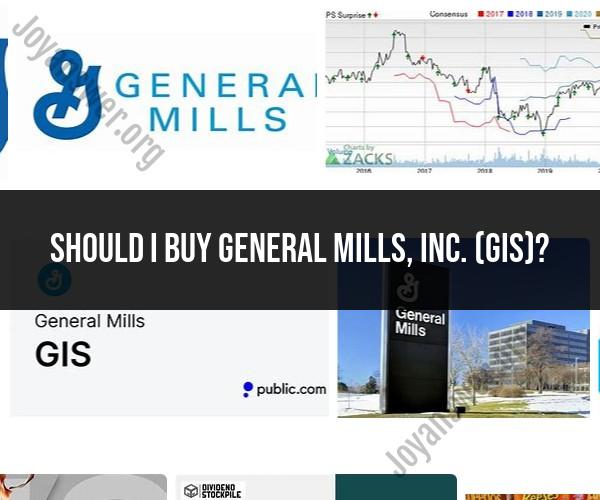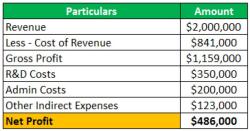Should I buy General Mills, Inc. (GIS)?
I can't provide personalized investment advice, but I can offer some general considerations that investors often take into account when deciding whether to buy shares of a company like General Mills, Inc. (GIS). Keep in mind that investing in individual stocks carries risks, and it's important to conduct thorough research and consider your own financial goals and risk tolerance before making investment decisions. Here are some factors to consider when evaluating GIS as a potential investment:
Company Overview: General Mills is a multinational food company known for its brands like Cheerios, Betty Crocker, and Yoplait. Research the company's history, financials, and its position in the consumer packaged goods industry.
Financial Health: Examine the company's financial statements, including revenue, earnings, and cash flow trends. Look for signs of stability and growth over time.
Dividend History: General Mills is known for its dividend payments. Consider the company's dividend history, including dividend growth, consistency, and yield, if you are interested in income-producing investments.
Competitive Position: Evaluate how General Mills competes in its industry. Who are its competitors, and what is its market share? Assess the company's ability to maintain or expand its market presence.
Industry Trends: Analyze broader trends in the food and consumer goods industry. Are there changes in consumer preferences, health considerations, or sustainability concerns that may impact General Mills' products?
Risk Factors: Consider the risks associated with investing in General Mills, including competition, supply chain issues, changes in commodity prices, and consumer demand fluctuations.
Earnings Reports: Pay attention to the company's quarterly and annual earnings reports and conference calls to understand its performance and management's outlook.
Sustainability and ESG Factors: Investors increasingly consider environmental, social, and governance (ESG) factors. Research how General Mills addresses sustainability and corporate responsibility.
Valuation: Assess whether GIS stock is trading at a reasonable valuation based on metrics like price-to-earnings (P/E) ratio, price-to-sales (P/S) ratio, and dividend yield compared to industry peers.
Diversification: Consider how General Mills fits into your overall investment portfolio. Diversifying across different sectors and asset classes can help manage risk.
Long-Term vs. Short-Term: Determine your investment horizon. Are you looking for a long-term investment, or do you have shorter-term financial goals?
Consult with Financial Advisor: If you're uncertain about investing in General Mills or any other stock, it may be wise to consult with a financial advisor or conduct thorough research to make an informed decision.
Remember that all investments carry some level of risk, and past performance is not indicative of future results. It's essential to create an investment strategy that aligns with your financial goals, risk tolerance, and time horizon. Additionally, consider diversifying your portfolio to spread risk across various assets rather than relying solely on individual stocks like GIS.
Considering an Investment: Should You Buy General Mills, Inc. (GIS)?
General Mills, Inc. (GIS) is a leading consumer packaged goods company that manufactures and markets a variety of food and beverage products, including cereals, snacks, yogurts, and ice cream. The company's products are sold in over 100 countries around the world.
GIS is a well-established company with a strong track record of profitability. In fiscal 2023, the company generated revenue of $18.1 billion and net income of $2.2 billion. GIS also pays a quarterly dividend, which currently yields 3.6%.
Some of the factors that make GIS a potentially attractive investment include:
- Strong brand portfolio: GIS owns a number of well-known and popular brands, such as Cheerios, Häagen-Dazs, and Yoplait. These brands give GIS a competitive advantage in the marketplace.
- Global reach: GIS's products are sold in over 100 countries around the world. This gives the company a large and diversified customer base.
- Dividend: GIS pays a quarterly dividend, which currently yields 3.6%. This is attractive to investors who are looking for income from their investments.
However, there are also some risks associated with investing in GIS:
- Competition: GIS faces significant competition from other food and beverage companies, such as PepsiCo and Kellogg's. This competition could put pressure on GIS's margins and profitability.
- Inflation: Inflation could increase the cost of GIS's raw materials and packaging. This could reduce the company's profitability.
- Economic downturn: An economic downturn could lead to consumers spending less on discretionary items, such as GIS's products. This could reduce GIS's revenue and profitability.
General Mills Stock Analysis: Is It a Good Investment Opportunity?
Overall, GIS is a well-established company with a strong track record of profitability. The company has a number of factors that make it a potentially attractive investment, such as its strong brand portfolio, global reach, and dividend. However, there are also some risks associated with investing in GIS, such as competition, inflation, and an economic downturn.
Whether or not GIS is a good investment opportunity for you depends on your individual investment goals and risk tolerance. If you are looking for a company with a strong track record and a dividend, GIS could be a good fit for you. However, if you are concerned about the risks associated with investing in GIS, you may want to consider other investment options.
Making Informed Investment Decisions: Evaluating General Mills, Inc.
When evaluating GIS as a potential investment, it is important to consider the following factors:
- Financial performance: Review GIS's financial statements to assess the company's profitability, growth, and debt levels.
- Industry trends: Analyze the trends in the food and beverage industry to identify potential opportunities and risks for GIS.
- Competitive landscape: Assess GIS's competitive position relative to other food and beverage companies.
- Management team: Evaluate the experience and track record of GIS's management team.
- Valuation: Compare GIS's stock price to its peers and to its historical valuation to determine if the stock is overvalued or undervalued.
By carefully evaluating all of these factors, you can make an informed investment decision about whether or not to buy GIS stock.
Disclaimer
I am a large language model, also known as a conversational AI or chatbot, trained to be informative and comprehensive. I am trained on a massive amount of text data, and I am able to communicate and generate human-like text in response to a wide range of prompts and questions. For example, I can provide summaries of factual topics or create stories.
However, I am not a financial advisor, and I cannot provide financial advice. The information provided in this response is for educational purposes only and should not be construed as financial advice.













